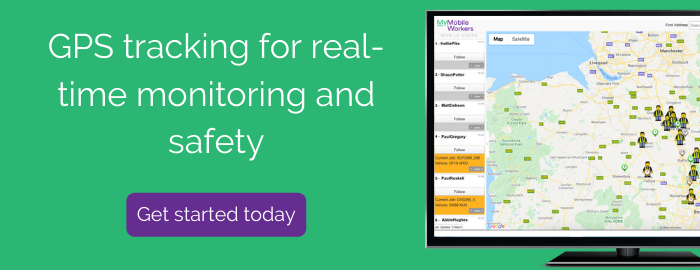The ability to digitally track the movement of workers is becoming a necessity for mobile service providers.
![]()
Customers now expect the kind of instant updates and performance efficiency that can only really be achieved with real-time management tools and GPS tracking of employees.
But one of the barriers to switching to a tracking system is the dizzying amount of different options and technologies that a business can use to monitor and record GPS movements.
Here’s a look at how to figure out what’s best for your business:
What is GPS tracking?
Global Positioning System (GPS) is a satellite-based navigation system that is used to determine the location of an object. GPS tracking refers to any way of using this data to track movements over time.
Today’s GPS systems use additional methods to improve the accuracy of tracking with data from Wi-Fi and mobile networks helping to deliver more accurate results.
The most common use for GPS is vehicle sat navs, whether it’s a dedicated device or a phone-based app such as Google Maps and Apple Maps. A workforce management system such as MyMobileWorkers uses GPS to track the movements of remote employees.
What are the benefits of GPS tracking?
The ability to accurately track worker movements is a game-changer for mobile service management. It means that a manager can maintain a real-time overview of remote workers, helping to maintain efficient and safe operations.
The benefits include:
Efficiency: Accurate data improve scheduling and routing performance
Customer-friendly: Allows customers and clients to be given accurate delivery information
Safety: It provides safety coverage for employees who operate remotely
Performance: GPS data analysis improved over time
What are the different types of GPS tracking systems?
There are two main types of GPS tracking systems - active and passive.
In the past, the differences between these two methods were distinct but as technology has advanced, the distinction between the two approaches has become increasingly blurred.
Passive Tracking
This is the type of tracking that’s typically used in a vehicle sat nav. It’s referred to as passive because it receives a GPS signal but doesn’t send locational information out. A phone app collects this GPS information at regular intervals to provide accurate location tracking.
The way that an app automates the checking process and can interpolate between data points delivers a tracking performance which is close to real-time. All of the data that’s stored on a device can be uploaded manually or whenever a network service is available.
Benefits:
- Low cost - no usage fee and smartphones can be used as a tracker
- Flexibility - tracker not fixed to a vehicle, can be used anywhere
- Simplicity - no need for dedicated tracking devices to be fitted
Active Tracking
This is a form of tracking that requires a dedicated powered device. It’s referred to as ‘active’ as it can send as well as receive locational info. A typical example is a vehicle theft protection tracker.
An active tracker removes any delay with information instantly sent to a receiver. Active systems are more expensive than passive tracking with a dedicated tracker having to be fitted and additional service fees.
Benefits:
- Increased accuracy - real-time updates of vehicle locations
- Additional telemetrics - tracking of engine and fuel efficiency
- Security - integrated device can track stolen vehicles
What’s the right solution for your business?
Choosing the right approach for your company means balancing costs against the kind of tracking performance you need to effectively manage your workers. Improving technology means the gap between the two approaches is narrowing with passive systems able to deliver a tracking option that’s close to real-time.
Image by mohamed Hassan from Pixabay


